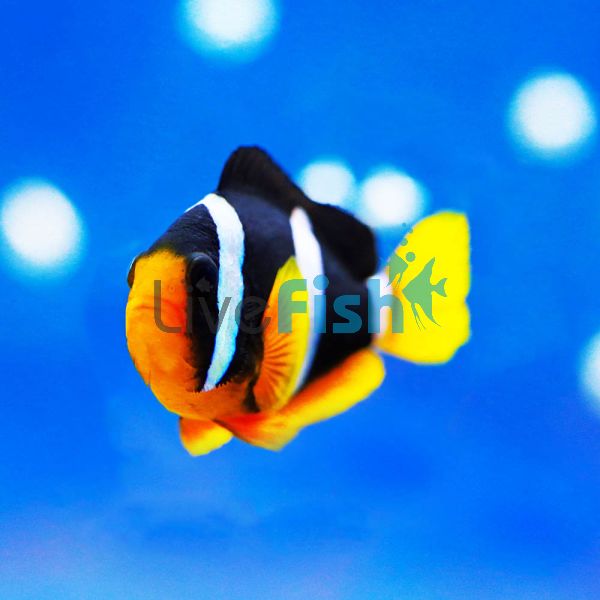Clownfish Clarks Indo PAC - Small
These Clownfish will make an excellent addition to your tank, especially when included with an anemone for them to call their home. The relationship between the Clownfish and anemone will keep you fascinated.
Clarks Clownfish
The Clarks Clownfish has a variety of coloring which ranges from brown to yellow in adults. Its body is covered by two white bands with a third band sometimes found on its’ tail. The nose and tail have separate colors which vary from yellow to white.
Clark’s Clownfish are usually found in shallow warm lagoons or sheltered reefs, mainly around certain types of anemones. They are active fish who like to swim around in the open. If they do feel the need to hide, they will find shelter in the reef.
Clark’s Clownfish reproduce by creating a spawning site, usually on live rock or a hard, rocky area with a vertical face. The fish clean the area, then the female swims over and deposits the eggs. The male follows and fertilizes them. Clark’s Clownfish grow to a max length of around 10 centimeters (4 inches). They can live for up to 14 years in an aquarium.
Tank Recommendations for Clark’s Clownfish
The smallest recommended tank size is 114 liters (30 gallons).
Clarks Clownfish will thrive in either a coral-rich tank or a fish-only tank, as long as there are some rocky areas in the fish-only tank, and anemone or other invertebrates in a coral tank. Clark’s Clownfish choose anemones as hosts but can also use substitutes, such as invertebrates, coral or rocks, or algae.
Suitable Tank Buddies
Clark’s Clownfish are good at co-habiting and can live alongside most fish that aren’t capable of swallowing them.
Usually Compatible
You can keep Clownfish with Damsels, large Angelfish, Blennies, Cardinalfish, Butterflyfish, Dragonets, and Hogfish without problems.
Sometime Compatible
They are semi-aggressive and have a tendency to pick on more peaceful fish, such as docile Damselfish. It is possible for them to share a tank with territorial fish such as perches, triggers, or large angelfish as long as the Clownfish is introduced first and kept with an anemone which offers protection
Rarely Compatible
Any fish big enough to swallow the Clownfish whole, like Anglers and Frogfish, and also don't keep Dottybacks in the same tank. If an adult pair of Clownfish have bonded, they will attack other pairs when protecting their territory.
Feeding Your Clark’s Clownfish
Clarke’s Clownfish are omnivores. In the wild, they eat a variety of meat and vegetation. This includes amphipods, zooplankton, polychaete worms, small shrimp, weeds, and benthic algae.
In an aquarium, they will eat algae that grow naturally in the tank and can live off a mixture of live, frozen, and flake foods. Live foods like mysis and brine shrimp are good.
Generally, you should feed Clownfish once a day, but for good health and breeding then 2 -3 light feedings is best. They can go a week without feeding if they are well fed and healthy, but this should not be a regular occurrence.
| Scientific Name | Amphiprion clarkii |
|---|---|
| Care Level | Moderate |
| Common Names | Clark's Anemonefish or Yellowtail Clownfish |
| Diet | Omnivore |
| Fish Family | Pomacentridae |
| Lifespan (years) | 14 |
| Max. Length (cm) | 10 |
| Min. Tank Volume (l) | 114 |
| Origin | Tropical waters of the Indo-Pacific region, Micronesia, Australia |
| Reef Safe | Yes |
| Sociability | Semi-aggressive |
| Venomous | No |
| Water Conditions | 22-26° C (72-78° F), dKH 8-12, pH 8.1-8.4, sg 1.020-1.025. |




